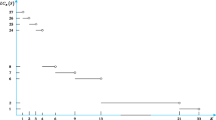Abstract
Generalizing the theory of k-error linear complexity for single sequences over a finite field, Meidl et al. (J. Complexity 23(2), 169–192 (2007)) introduced three possibilities of defining error linear complexity measures for multisequences. A good keystream sequence must possess a large linear complexity and a large k-error linear complexity simultaneously for suitable values of k. In this direction several results on the existence, and lower bounds on the number, of single sequences with large k-error linear complexity were proved in Meidl and Niederreiter (Appl. Algebra Eng. Commun. Comput. 14(4), 273–286 (2003)), Niederreiter (IEEE Trans. Inform. Theory 49(2), 501–505 (2003)) and Niederreiter and Shparlinski (In: Paterson (ed.) 9th IMA International Conference on Cryptography and Coding (2003)). In this paper we discuss analogous results for the case of multisequences. We also present improved bounds on the error linear complexity and on the number of sequences satisfying such bounds for the case of single sequences.
Similar content being viewed by others
References
Berlekamp E.R. (1968). Algebraic Coding Theory. McGraw-Hill, New York
Dai Z., Imamura K., Yang J.: Asymptotic behavior of normalized linear complexity of multi-sequences. In: Helleseth T., Sarwate D.V., Song H.Y., Yang K. (eds.) Sequences and Their Applications—SETA 2004, Lecture Notes in Computer Science, vol. 3486, pp. 129–142. Springer, Berlin (2005).
Dawson E., Simpson L. (2002). Analysis and design issues for synchronous stream ciphers. In: Niederreiter H. (eds) Coding Theory and Cryptology. World Scientific, Singapore, pp. 49–90
Ding C. (1988). Proof of Massey’s conjectured algorithm. In: Günther C.G. (eds) Advances in Cryptology— EUROCRYPT ’88, Lecture Notes in Computer Science, vol. 330. Springer, Berlin, pp. 345–349
Ding C. (1990). Lower bounds on the weight complexities of cascaded binary sequences. In: Seberry J., Pieprzyk J. (eds) International Conference on Cryptology—AUSCRYPT ’90, Lecture Notes in Computer Science, vol. 453. Springer, Berlin, pp. 39–43
Ding C., Xiao G., Shan W. (1991). The Stability Theory of Stream Ciphers, Lecture Notes in Computer Science, vol. 561. Springer, Berlin
Fell H.J. (1991). Linear complexity of transformed sequences. In: Cohen G.D., Charpin P. (eds) EUROCODE ’90, Lecture Notes in Computer Science, vol. 514. Springer, Berlin, pp. 205–214
Feng X., Dai Z. (2005). Expected value of the linear complexity of two-dimensional binary sequences. In: Helleseth T., Sarwate D.V., Song H.Y., Yang K. (eds) Sequences and Their Applications—SETA 2004, Lecture Notes in Computer Science, vol. 3486. Springer, Berlin, pp. 113–128
Fu F.W., Niederreiter H., Su M. (2005). The expectation and variance of the joint linear complexity of random periodic multisequences. J. Complexity 21(6): 804–822
Hawkes P., Paddon M., Rose G.G., de Vries M.W.: NLS, ECRYPT candidate. http://www.ecrypt.eu.org/stream/ciphers/nls/nls.pdf. Accessed Oct. 2007.
Hawkes P., Paddon M., Rose G.G., de Vries M.W.: SSS, ECRYPT candidate. http://www.ecrypt.eu.org/stream/ciphers/sss/sss.pdf. Accessed Oct. 2007.
Hawkes P., Rose G.G. (2000). Exploiting multiples of the connection polynomial in word-oriented stream ciphers. In: Okamoto T. (eds) Advances in Cryptology – ASIACRYPT 2000, Lecture Notes in Computer Science, vol. 1976. Springer, Berlin, pp. 303–316
Lidl R., Niederreiter H. (1997). Finite Fields, 2nd edn. Cambridge University Press, Cambridge
Meidl W., Niederreiter H. (2003). The expected value of the joint linear complexity of periodic multisequences. J. Complexity 19(1): 61–72
Meidl W., Niederreiter H. (2003). Periodic sequences with maximal linear complexity and large k-error linear complexity. Appl. Algebra Eng. Commun. Comput. 14(4): 273–286
Meidl W., Niederreiter H., Venkateswarlu A. (2007). Error linear complexity measures for multisequences. J. Complexity 23(2): 169–192
Niederreiter H. (2003). Linear complexity and related complexity measures for sequences. In: Johansson T., Maitra S. (eds) Progress in Cryptology—INDOCRYPT 2003, Lecture Notes in Computer Science, vol. 2904. Springer, Berlin, pp. 1–17
Niederreiter H. (2003). Periodic sequences with large k-error linear complexity. IEEE Trans. Inform. Theory 49(2): 501–505
Niederreiter H. (2006). The probabilistic theory of the joint linear complexity of multisequences. In: Gong G., Helleseth T., Song H.Y., Yang K. (eds) Sequences and Their Applications – SETA 2006, Lecture Notes in Computer Science, vol. 4086. Springer, Berlin, pp. 5–16
Niederreiter H., Shparlinski I. (2003). Periodic sequences with maximal linear complexity and almost maximal k-error linear complexity. In: Paterson K.G. (eds) 9th IMA International Conference on Cryptography and Coding, Lecture Notes in Computer Science, vol. 2898. Springer, Berlin, pp. 183–189
Niederreiter H., Wang L.P. (2005). Proof of a conjecture on the joint linear complexity profile of multisequences. In: Maitra S., Madhavan C.E.V., Venkatesan R. (eds) Progress in Cryptology – INDOCRYPT 2005, Lecture Notes in Computer Science, vol. 3797. Springer, Berlin, pp. 13–22
Niederreiter H., Wang L.P. (2007). The asymptotic behavior of the joint linear complexity profile of multisequences. Monatshefte für Mathematik 150(2): 141–155
Sakata S. (1990). Extension of the Berlekamp–Massey algorithm to N dimensions. Inform. Comput. 84(2): 207–239
Stamp M., Martin C. (1993). An algorithm for the k-error linear complexity of binary sequences with period 2n. IEEE Trans. Inform. Theory 39(4): 1398–1401
van Lint J.H. (1982). Introduction to Coding Theory. Springer, Berlin
Wang L.P., Niederreiter H. (2006). Enumeration results on the joint linear complexity of multisequences. Finite Fields Their Appl. 12(4): 613–637
Wang L.P., Zhu Y.F., Pei D.Y. (2004). On the lattice basis reduction multisequence synthesis algorithm. IEEE Trans. Inform. Theory 50(11): 2905–2910
Author information
Authors and Affiliations
Corresponding author
Rights and permissions
About this article
Cite this article
Niederreiter, H., Venkateswarlu, A. Periodic multisequences with large error linear complexity. Des. Codes Cryptogr. 49, 33–45 (2008). https://doi.org/10.1007/s10623-008-9174-x
Received:
Revised:
Accepted:
Published:
Issue Date:
DOI: https://doi.org/10.1007/s10623-008-9174-x
Keywords
- Multisequences
- Joint linear complexity
- Error linear complexity
- Stream ciphers
- Berlekamp–Massey algorithm




